I often have to pinch myself. My life has many extraordinary
moments. It takes awhile to come back down to earth and I ask myself, “Did that
really happen?”
 |
| No sight of land for 36 hours |
Last Friday we flew to Hobart for another
boat delivery job;
we were ready for some cooler weather too as Brisbane was heating up. The
flight was nearly full, and oh so very quiet: did not hear a peep out of anyone
nor anyone’s device for 2 ¼ hours. Coming from Fortress Queensland, we had no
trouble entering the Apple Isle. We answered rapid-fire questions regarding
Covid-19 exposure and baggage contents from an assigned airport officer, then collected our bags from the broken-down carousel and headed for the Share Ride
stand to catch an Uber.
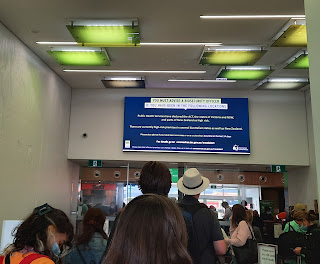 |
| Social distancing queue waiting for questioning |
It was a lovely drive in the country, made more scenic (is
that ever possible in Tasmania?) as the road side edges were carpeted with
white wildflowers for most of the 72-kilometre journey to Triabunna. We were
last there in February when, after a yacht delivery, we borrowed a friend’s
motorhome for a couple of weeks and stopped at the infamous Fish Van for lunch
as we passed through. Before that, in 2012 we camped in Delvy across
from the marina, which is now a carpark for the marina extension. We had fish
and chips then too.
 |
| Delvy camp in 2012 |
 |
| How times change. The 2012 camping spot on the left of this photo. |
Arriving at Triabunna, we met the seller of the commercial
cray fishing vessel for a boat brief and handover. Normally we would stay on
board prior to a delivery, but the facilities were quite rudimentary, and it
was cold. Even the locals were complaining. So, we booked a cabin 300 metres up
the road in the caravan park for a couple of nights and made use of the heat
pump, bathroom and cooking facilities.
 |
| Triabunna wharf |
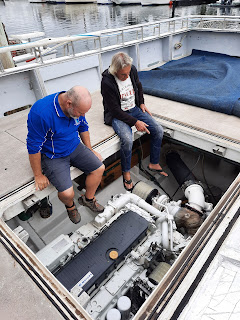 |
| At 750 hp we should get to our destination a little quicker than we're used to. |
 |
| A lunch time cook up at Cabin 3 |
In between boat preparation, we ate fish
and chips, explored the pretty village and the Pelican Walk (sans pelicans)
and chatted with friendly folk along the way. There were a few RVs around, with
a group parked in The Village, a community art and garden space, for their
Christmas get together. We’ll have to bring Delvy back to Tassie one day
and enjoy all the freedom camp spots – there are so many.
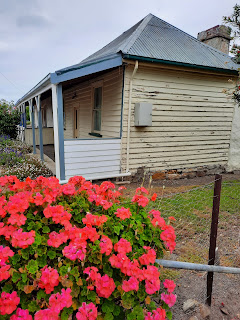 |
| Pretty geraniums |
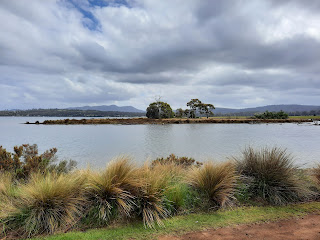 |
| Along the Pelican Walk |
 |
| Triabunna community green, with art studios, galleries and function room |
Sunday afternoon rolled around and the weather said it was
time to fuel up and go. Armed with our wet weather gear, sea boots and thermals
(a major contrast to last month’s boat delivery in shorts and t-shirts), we followed
the Maria Island ferry out through the leads in Spring Bay and turned north towards Schouten
Island. The sea was still a bit lumpy with left over easterly swell, but we
were happy with how the boat was performing, even if there were no sails. After
some engine and fuel checks, we made our way through the passage into the
Tasman Sea. Negotiating our way through a monster jelly fish mine field, and avoiding
sucking one up through the raw water intake, we spotted a large vessel heading
towards us on our starboard side. We identified it was a survey vessel, and
coincidentally it had persons on board that we worked with last year in the
Whitsundays doing hydrographic work. Small world. It would be the only vessel
we would see for the next 16 hours.
 |
| Fuel capacity 1800 litres plus 1000 litre IBC on deck |
 |
| East Coast of Tasmania |
 |
| All systems good |
With the setting sun, watchkeeping shifts commenced as we motored
up the east coast towards the Furneaux Island Group, our next fuel stop if
required. The long summer twilight stretched out to about 10.00pm, then the
waxing moon took over the illumination of the night sky. It was too cloudy to
see the Geminid meteor shower forecasted to be at their peak this very night,
but it was still a magical evening as we rolled over the ocean swell. Feeling
like we’re travelling twice the speed in the dark, first light appeared at 4.30am, like someone had minutely turned up the dimmer switch, and I relaxed a
little. I could now again see what was in front of me, and could avoid anything
if need be. Colliding with a wayward shipping container or enormous marine
animal weighs on one’s mind when travelling at speed in the dark. The
consequences could be dire so a regular run through of emergency drills is a
must, as is a few crossed fingers.
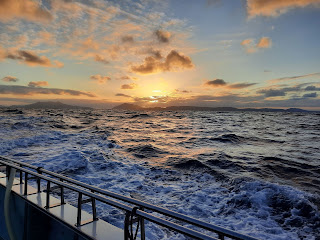 |
| Love the long southern summer evenings |
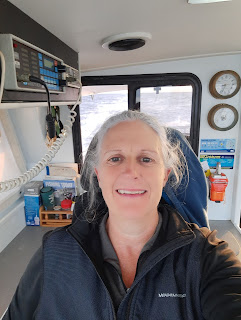 |
| First night watch over |
Orange colour smeared the sky and we were greeted by several
albatross, dynamic soaring, like they were floating just
above the water, disappearing then reappearing from the trough of the near 2-metre
swell. Their enormous wing span never flapping: it's mesmerising
to watch. Sometimes they sit, their large size mistaken for a buoy in the
distance, and reluctantly they launch themselves away from our approach. Large webbed feet pad clumsily across the water, with wings now frantic to get the lift needed to fly. We almost feel guilty for the intrusion but admire their effort.
On sunrise, abeam of Cape Barron
Island, it was time to transfer some fuel from the IBC to the main tanks and do
some calculations. Can we cross Bass Strait and get to Eden on the fuel we
have? Yes, we can. Let’s go! Goodbye land and all internet for 24 hours. Apart
from a fishing boat off to the west, we are alone in the big blue sea and a big
blue sky. No sound but the ocean and the low drone of the 750 hp engine. The
air is crisp and clean, with the faintest whiff of diesel.
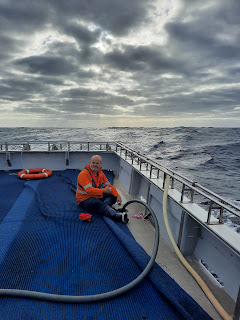 |
We slowed the boat down for the gravity fed transfer
Getting message out to new owner that we're ready to make the crossing |
 |
| Sea and weather conditions just kept getting better as we headed north |
We were now into the rhythm of an
ocean passage, alternating between 2 hours on watch and 2 hours sleep or rest,
and snacking from time to time. When there’s a bit of motion on the boat,
appetites become small and there’s minimal effort to produce something to eat.
Heinz chunky soups are an easy option for something substantial, interspersed
with chocolate, tea, coffee, dry savoury biscuits, and half a Kwell to keep the
sea sickness at bay.
The bright sunny day turned into
a cloudless second night. The stars seemed touchable, hanging low: the
constellations so distinguishable. With the 360-degree flat horizon it looked
like we were motoring into the sky. Come morning, we transferred more of the
1000 litres of diesel and calculated we had enough fuel to make it to Jervis
Bay with 30% reserve, provided we averaged 9 knots. The 44-foot Conquest was
capable of doing 16 knots, but at a burn of 100 litres per hour that wasn’t
prudent compared to an hourly rate of 40 or less litres.
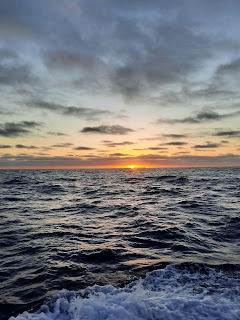 |
| Sunrise front row seat |
And so, we plodded along, but
compared to our usual yacht deliveries we thought it was fast. This was our 5th
Bass Strait crossing for the year, but the endless blue and marine life never
get tiring. The birds continued to fascinate us, and a pod of pilot whales looking
like small grey battleships made us slowdown for a better look. Of course, the
usual dolphins came out to play, briefly this time, and at one stage I caught a
glimpse of a large shark fin and a seal.
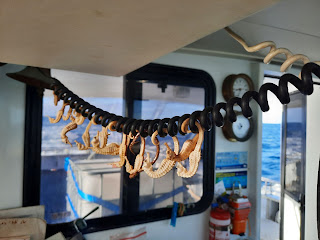 |
| Seahorse collection in the wheelhouse |
The sea continued to flatten as
we headed towards the Victorian coast, the wind disappearing altogether: ideal
sea conditions for a motor boat. Land was sighted again: the big island, and keeping
about 10 nautical miles offshore out of the EAC, we continued north. The bright
sunshine had us stripped down to shorts and t-shirts. A lone blue bottle jellyfish drifted past; a white
triangle appeared on the horizon further east; a container ship silently slipped
by. That was the only activity we saw all day. Two hours out from our
destination, it was time to put the foot down so we could make our anchorage
before dark.
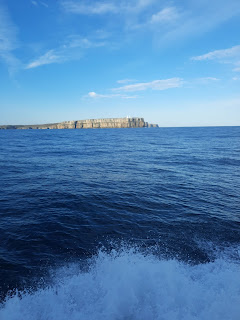 |
| On the home stretch now |
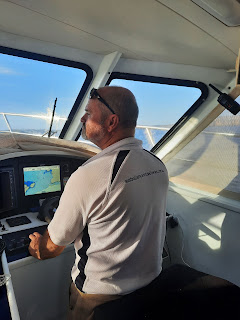 |
| Master Gary steering us safely into Jervis Bay |
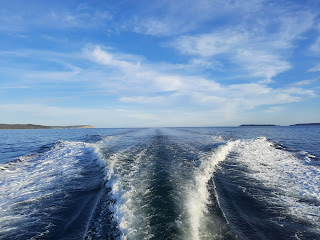 |
| Stunning late afternoon in Jervis Bay |
 |
| Safe and sound on mooring |
 |
| Sunset looking towards entrance to the bay |
Some 52 hours, 500 nautical miles
and 2400 litres of fuel later, we picked up the new owner’s mooring off Shark
Net Beach and switched the engine off. Silence. We made it. After a sound
night’s sleep, we were collected in a workboat and transferred to Huskisson Wharf
at dawn, given a hot shower and breakfast and dropped off at the train station.
Mission complete, sea adventure over. Another successful delivery. Now it’s time to reunite with Delvy
and spend Christmas with family. And continue to pinch myself.
 |
| Early morning pickup from mooring |
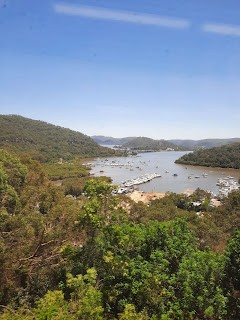 |
| Such a scenic train journey |
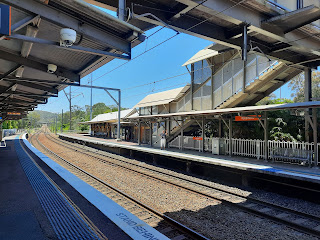 |
| Mum waiting for us on the platform. |



























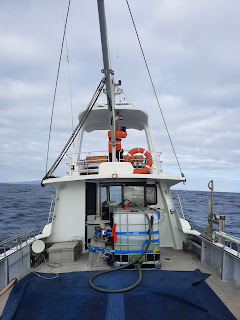
No comments:
Post a Comment